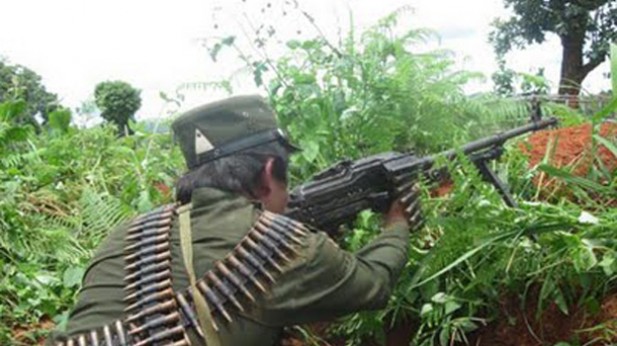More than 1,000 ethnic Shan villagers from Tangyan Township, Shan State, have fled from their homes due to atrocities by Burmese government forces, a human rights group said on Friday.
The Shan Human Rights Foundation said the influx of residents from 16 villages in the eastern state began two weeks ago due to the government army’s new operation against the Shan State Army-North (SSA-North), an ethnic Shan militia that signed a ceasefire agreement with the government in January 2012.
The government army began deploying forces to the region after asking the SSA-North to withdraw from military bases at two strategic mountains. The Shan rebels refused.
In response, the government army has sent more than 1,000 troops since February to frontlines along the Salween River, near Tangyan and the Shan rebels’ mountain bases.
In a report released on Friday, the Shan Human Rights Foundation said armed clashes between both sides were continuing, adding that government troops had set land mines and committed rights violations against local civilians.
The rights group said villagers were afraid to stay in their villages any longer and had fled to the town of Tangyan. An estimated 700 ethnic Shan, Palaung and Lahu villagers are sheltering in several temples and a school in the town, while others are hiding in the jungle, according to the report.
Ying Harn Fah, a spokesperson for the Shan Women’s Action Network, a women’s rights organization, said the influx of refugees in Tangyan suggested the government did not genuinely want to attain peace in the country.
“Despite the ceasefire, the villagers still suffer from abuses,” she said. “If they [the government] really want peace, they should obey the principles of the ceasefire agreement.”
According to the rights group report, three ethnic Palaung teenage girls were arrested last week and forced to work for two days and nights at a Burmese military base.
Two men were also arrested on the same day and forced to work as porters, the report said. The men later died after stepping on landmines while carrying supplies for the government army, the report claimed.
The SSA-North reached a ceasefire with the government in 1989, but the deal broke down in March 2011 when the government army launched a military offensive against the Shan rebels, displacing more than 30,000 civilians.
The government signed a new ceasefire deal with the SSA-North again in January last year, but the deal has been unstable.
Maj Sai Hla, a spokesperson for the SSA-North, said the ceasefire could break down if the government continued its offensive.
“In the year since we reached the ceasefire, about 100 clashes, including major and minor ones, have broken out,” Sai Hla said. “If they keep reinforcing their troops, it may lead to major offensive. And the ceasefire could break down.”
Maj-Gen Sao Hso Ten, a leader of the Shan State Peace Council in Rangoon, added: “We sent a letter to President Thein Sein. We demanded that he force the government army to cease the fighting. But, they [the government] can’t hold them [the troops] accountable.”
Some observers and journalists have speculated that the government army likely wants to control the mountains where the Shan troops are now stationed in order to prepare a military offensive against ethnic Wa rebels in the United Wa State Army (UWSA).
One Shan journalist said the mountains were a militarily strategic location from which to launch an offensive against the Wa rebels, with close proximity to the Wa region.
With additional reporting by Irrawaddy reporter Nang Sai Nom in Rangoon.
















